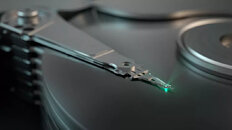Wednesday, October 28th 2020

Seagate: 20 TB HAMR Drives Arrive in December, 50 TB Capacities in 2026
In its latest earnings call, Seagate, a manufacturer of high-capacity drives, has revealed several interesting points about its upcoming releases of next-generation hard drives. More specifically, the company has disclosed a shift to a new generation of HDDs based on so-called heat-assisted magnetic recording (HAMR) technology. This technology is set to bring many improvements compared to the one currently used by Seagate's rivals like Western Digital. The rivaling company uses energy-assisted perpendicular magnetic recording (ePMR) and microwave-assisted (MAMR) technologies and it already has a 20 TB drive in the offering. Seagate announced that they will unveil a 20 TB HDD in December this year, with the use of HAMR technology, which will bring many improvements like better speed and more efficient disk read/write.
"We remain on track to ship 20-TB HAMR drives starting in December, which is an important milestone, as we believe HAMR technology will be the industry's path to scaling a real density and increasing drive capacities," said Dave Mosley, CEO of Seagate. "Seagate will be the first to ship this crucial technology with a path to deliver 50-TB HAMR drives forecast in 2026."
Source:
Seagate Earnings Call (Transcript)
"We remain on track to ship 20-TB HAMR drives starting in December, which is an important milestone, as we believe HAMR technology will be the industry's path to scaling a real density and increasing drive capacities," said Dave Mosley, CEO of Seagate. "Seagate will be the first to ship this crucial technology with a path to deliver 50-TB HAMR drives forecast in 2026."

60 Comments on Seagate: 20 TB HAMR Drives Arrive in December, 50 TB Capacities in 2026
Also, the typical use case would to not fill it right away from the get-go but instead, it would be filled throughout the course of it's storage needs which is usually in years.That & the prosumer market. Eventually the consumers might be able to afford one a decade down the line.
:roll::roll::roll:
And then there is the SSD GB cost to consider. It's been going down quite a bit in these last years, and I kinda expect that trend to continue for years to come, so it seems to me that in a decade most home users will simply have one big SSD for most things, while throwing everything else to the Internet (be that social media networks or cloud storage like OneDrive or Google Drive). Well, if the whole game streaming service thing doesn't take off at all, make that two big SSDs :D
Sure SSD pricing have dropped considerably to being easily affordable but it seems that HDD is also dropping in price while still being considerably larger in capacity & longevity.LOL, I just did that earlier this month except it was 60GB HDD PATA-to-USB over a USB 1.1 on a 2002 laptop (which is why there is no USB 2.0). To be fair though, this was planned to be done overnight which must've took nearly 20 hours, I think.
edit: they said there will be 100tb drive in 2020
I think the enterprise sector & maybe the professional sector is still using eMLC.
Correct me if I'm wrong, but it seems like 3D NAND & V-NAND has been doing only decent job of complimenting TLC & QLC's longevity & reliability. Any takes?
But the sourcefor the table is almost a decade old, so there may have been some improvements.
Anyway, thanks for this, Windwhirl.
What's really helped is a whole slew of new controller algorithms that load-balance better. In particular, the proliferation of "static wear leveling", which means static blocks move around the drive.
For example: lets say you have a 350GB drive, and 300GBs of it is used "statically" (write once, read many use case. Like videos, pictures, archived tax documents, and the like). Under older algorithms (just 5 years ago), only the "free" 50GBs was wear leveled. (IE: Dynamic wear leveling). Under today's controller algorithms, all 350GBs are wear-leveled. Those "rarely written" video files will be moved to other blocks, so that those cells can be "cycled".
As such, a 1TB TLC SSD will have very good wear leveling, there's almost always a large amount of static-files in a typical consumer workload.